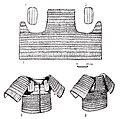Filippovka kurgans
51°20′35″N 54°07′01″E / 51.342968°N 54.116974°E
| Filippovka kurgans | |
|---|---|
Sauro- ) and contemporary cultures circa 325 BCEmatians |
The Filippovka kurgans (Ru: Филипповский курганный) are Late-
Characteristics
The style of the artifacts from the Filippovka kurgans is considered as Scythian
The numerous burials at Filippovka are dated to the 2nd half of the 5th century and the 4th century (c.450-300 BCE), and correspond to the Early Sarmatian culture of the southern Ural region.[4]
The style of many artifacts looks quite archaic, prompting some historians to date them to the 6th century BCE and to the
The finds of weaponry in the Filippovka kurgans also allowed for the definition of the Early Sarmatian heavy-armed warrior: "He wore a forged-iron helmet with a nose piece and cheek pieces. Scale armor of leather protected his body. He carried a twig-woven quiver for a bow and sometimes more than 200 arrows, covered with leather and decorated with an umbo; an arms belt with a buckle for crossing the belts; a richly decorated quiver hook; a long spear with a massive head and spike; a short iron
-
Gold amphora with argali-shaped handles, Filippovka kurgan 1, 4th century BCE.
-
Filippovka kurgans cup
-
Bear-shaped vessel, Filippovka kurgan 1, 4th century BCE.
-
Mirror, Filippovka kurgan 1, 4th century BCE.[1]
-
Silver ewer, Filippovka kurgan 1, 4th century BCE.
-
Earrings, Filippovka kurgan 1, 4th century BCE.
Weapons
Numerous weapons, armour, helmets were found in the excavations of Filippovka kurgan 1:[5]
-
Filippovka 1 Iron armour from burial 2 mound 4
-
Filippovka 1, Horn armour from mound 29
-
Filippovka 1, bronze arrowheads from burial 2, mound 4
-
Filippovka 1, iron helmets from mound 11
-
Filippovka 1, iron swords and daggers
Anthropology

The people buried in Filippovka combined Western (
In skull shape and facial structure, the Filippovka specimens differ considerably from remains of Scythians and Volga River-area Sarmatians. The Filipovka skulls most closely resemble those of Saka from Kazakhstan and the Aral Sea region, and those of the Usuns from Eastern Kazhakhstan.
— The Golden Deer of Eurasia: Scythian and Sarmatian Treasures from the Russian Steppes.[7]

Ethnic context

The region between the
As a result, a large-scale integrated union of nomads from Central Asia formed in the area in the 5th–4th century BCE, with fairly uniformized cultural practices.[14] This cultural complex, with notable ‘‘foreign elements’’, corresponds to the ‘‘royal’’ burials of Filippovka, and define the "Prokhorovka period" of the Early Sarmatians.[14]
See also
- Taksai kurgan, about 100 km to the west
- Araltobe kurgan
References
- ^ .
- ^ ISSN 0002-9114.
with artifacts found in other barrows, afford us the opportunity to refine the chronology of each object and of the site as a whole and to date it to the second half of the fifth through the fourth centuries B.C.E. (...) Filippovka cemetery is a transition site between the Sauromation and the Sarmatian epochs.
- ^ .
- ^ a b c d Yablonsky, Leonid Teodorovich (2010). "New Excavations of the Early Nomadic Burial Ground at Filippovka (Southern Ural Region, Russia)". American Journal of Archaeology. 114 (1).
- ^ Yablonsky, L.T. (2013). "РАННЕСАРМАТСКИЙ РЫЦАРЬ (Sarmatian warrior)" (PDF). Поволжская археология (The Volga River Region Archaeology). 2 (4): 104–135.
- ISSN 0002-9114.
- ^ ISBN 978-0-87099-959-8.
- ISBN 978-0-87099-959-8.
- ISBN 978-0-87099-959-8.
- ISSN 1960-1360.
The use of the technique of decorating iron and bronze objects with gold inlays by the nomads of Eurasia already in the 7th century BC is attested by the decoration of a battle axe (Čugunov et al., 2006: 121, no. 13, pl. 26) and arrowheads (Čugunov et al., 2006: 123-124, no. 16, pls. 31-32) from the princely Arzhan-2 barrow in Southern Siberia (Armbruster, 2007: 99). This technique remained in use in the period between the 6th and the 4th century BC, as indicated by the finds of: a gold-inlaid iron knife handle in the Shibe barrow in Southern Siberia (Popescu et al., 2001: no. 201), a gold-inlaid iron pin in the barrow no. 22 of the cemetery Doge-Bary in Tuva (Čugunov, 1998: 302, Fig. 16, 3), and the plaques in the barrow no. 3 of the Tasmola-V necropolis in Central Kazakhstan (Popescu et al., 1998: nos. 145-150). The locations of the finds span the vast belt stretching from the Altai Mountains in the east to the Southern Urals in the west.
- ISSN 0960-9822.
- ISBN 978-0-87099-959-8.from Eastern Kazhakhstan.
In skull shape and facial structure, the Filippovka specimens differ considerably from remains of Scythians and Volga River-area Sarmatians. The Filipovka skulls most closely resemble those of Saka from Kazakhstan and the Aral Sea region, and those of the Usuns
- .
- ^ ISSN 0960-9822.
Sources
- Okorokov, Konstantin; Tregubov, Vyacheslav (June 2021). "About Women's Clothing with Decorated Sleeves from the Filippovka I Kurgan Cemetery (CC BY 4.0)". Nizhnevolzhskiy Arheologicheskiy Vestnik (я): 51–68. .
- Okorokov, Konstantin (June 2022). "Items of Clothing from the Early Nomadic Kurgans in the Southern Urals: Iconography and Burial Practice (Based on the Materials of Cemeteries Filippovka 1 and Filippovka 2) (CC BY 4.0)". Nizhnevolzhskiy Arheologicheskiy Vestnik (1): 66–90. .
- Okorokov, Konstantin; Perevodchikova, Elena (July 2020). "The 2013 Finds in the Context of the Animal Style of the Kurgan 1 of the Necropolis Filippovka 1 (CC BY 4.0)". Nizhnevolzhskiy Arheologicheskiy Vestnik (1): 28–45. .
- Anikeeva, Olga; Kolganova, Galina (July 2020). "Jewellery from Burial 2 Kurgan 1 Filippovka 1 Cemetery: Manufacturing Techniques, Purpose and Semantics of Images (CC BY 4.0)". Nizhnevolzhskiy Arheologicheskiy Vestnik (1): 6–27. .





![Mirror, Filippovka kurgan 1, 4th century BCE.[1]](http://upload.wikimedia.org/wikipedia/commons/thumb/8/8a/%D0%97%D0%BE%D0%BB%D0%BE%D1%82%D0%BE_%D1%81%D0%B0%D1%80%D0%BC%D0%B0%D1%82%D1%81%D0%BA%D0%B8%D1%85_%D0%B2%D0%BE%D0%B6%D0%B4%D0%B5%D0%B9._Gold_of_the_Sarmatian_-_Mirror%2C_Filoppovka.jpg/69px-%D0%97%D0%BE%D0%BB%D0%BE%D1%82%D0%BE_%D1%81%D0%B0%D1%80%D0%BC%D0%B0%D1%82%D1%81%D0%BA%D0%B8%D1%85_%D0%B2%D0%BE%D0%B6%D0%B4%D0%B5%D0%B9._Gold_of_the_Sarmatian_-_Mirror%2C_Filoppovka.jpg)






